A Review of Plasma-Synthesized and Plasma Surface-Modified Piezoelectric Polymer Films for Nanogenerators and Sensors
Abstract
:1. Introduction
2. Plasma Process
2.1. Plasma Deposition and Synthesis Process of the Piezoelectric ZnO NPs and Polymers
2.1.1. Plasma Deposition and Synthesis Process of the Piezoelectric ZnO NPs
2.1.2. Plasma Deposition and Synthesis Process of the Piezoelectric Polymer Using APP Technique
2.2. Plasma Surface Modification of the Piezoelectric ZnO and Polymers Using Plasma Process
2.2.1. Plasma Surface Modification of the Piezoelectric ZnO Film for Sensor Application
2.2.2. Plasma Surface Modification of Piezoelectric Polymer Using Plasma Process
2.2.3. Plasma Surface Modification of Triboelectric Polymer Using Plasma Process
3. Conclusions
Author Contributions
Funding
Institutional Review Board Statement
Informed Consent Statement
Data Availability Statement
Conflicts of Interest
Abbreviations
| NPs | Nanoparticles |
| NGs | Nanogenerators |
| PENGs | Piezoelectric NGs |
| TENGs | Triboelectric NGs |
| ZnO | Zinc oxide |
| PZT | Lead zirconate titanate |
| BaTiO3 | Barium titanate |
| PMN–PT | Lead magnesium niobate–lead titanate |
| PVDF | Polyvinylidene fluoride |
| P[VDF–TrFE] | Poly(vinylidenefluoride–co–trifluoroethylene) |
| PAN | Polyacrylonitrile |
| APP | Atmospheric pressure plasma |
| PECVD | Plasma-enhanced chemical vapor deposition |
| PMMA | Polymethylmethacrylate |
| SEM | Scanning electron microscope |
| CF | Carbon fiber |
| PFM | Piezoresponse force microscopy |
| d33 | Piezoelectric coefficient |
| APPJ | Atmospheric pressure plasma jet |
| PE–ALD | Plasma-enhanced atomic layer deposition |
| PET | Poly(ethylene terephthalate) |
| ICCD | Intensified charge-coupled device |
| DMF | Dimethylformamide |
| FT-IR | Fourier transform infrared spectroscopy |
| Modified–APPDS | Modified APP deposition system |
| NFs | Nanofibers |
| RF | Radio frequency |
| ICPS | Inductively coupled plasma source |
| O2 | Oxygen |
| H2 | Hydrogen |
| Ar | Argon |
| XPS | X-ray photoelectron spectroscopy |
| PVDF–HFP | Poly (vinylidene fluoride–hexafluoropropylene) |
| PVDF–CTFE | Poly(vinylidene fluoride–chlorotrifluoroethylene) |
| Ra | Average surface roughness |
| LPP | Low-pressure plasma |
| PDMS | Polydimethylosiloxane |
| PTFE | Polytetrafluoroethylene |
| Ag | Silver |
| WCA | Water contact angle |
| CNT | Carbon nanotubes |
| He | Helium |
| CB | Carbon black |
| THF | Tetrahydrofuran |
| T–TENG | Textile TENG |
| RIE | Reactive-ion etching |
| C–F | Fluorocarbon |
| HWA | Hierarchical wrinkled architecture |
| CSM | Chemical surface modification |
| PSM | Physical surface modification |
| SEBS | Styreneethylene–butylene–styrene |
| LIS | Linear ion source |
| PPFC | Plasma polymer–fluorocarbon |
| N2 | Nitrogen |
| WA | Wrinkled architecture |
| PPFC | Plasma polymer–fluorocarbon |
| SMCs | Surface-modified carbon nanotubes |
| CCP | Capacitively coupled plasma |
| PEDOT:PSS | Poly(3,4-ethylenedioxythiophene):poly(styrenesulfonate) |
| RRMS | Root–mean–square surface roughness |
| Ems | Eggshell membranes |
| Al | Aluminum |
| PI | Polyimide |
References
- Mahajan, A.; Goel, A.; Verma, A. A review on energy harvesting based piezoelectric system. Mater. Today Proc. 2021, 43, 65–73. [Google Scholar] [CrossRef]
- Ali, A.; Shaukat, H.; Bibi, S.; Altabey, W.A.; Noori, M.; Kouritem, S.A. Recent progress in energy harvesting systems for wearable technology. Energy Strategy Rev. 2023, 49, 101124. [Google Scholar] [CrossRef]
- Halim, M.A.; Hossain, M.M.; Islam, M.S.; Khatun, E. A review on techniques and challenges of energy harvesting from ambient sources. Int. J. Sci. Eng. Res. 2022, 13, 1254–1263. [Google Scholar] [CrossRef]
- Mohanty, A.; Parida, S.; Behera, R.K.; Roy, T. Vibration energy harvesting: A review. J. Adv. Dielectr. 2019, 9, 1930001. [Google Scholar] [CrossRef]
- Iqbal, N.; Masood, M.; Nasir, A.A.; Qureshi, K.K. Review of contemporary energy harvesting techniques and their feasibility in wireless geophones. Int. J. Energy Res. 2022, 46, 5703–5730. [Google Scholar] [CrossRef]
- Banerjee, S.; Bairagi, S.; Ali, S.W. A lead-free flexible piezoelectric-triboelectric hybrid nanogenerator composed of uniquely designed PVDF/KNN-ZS nanofibrous web. Energy 2022, 244, 123102. [Google Scholar] [CrossRef]
- Sun, Y.; Liu, Y.; Zheng, Y.; Li, Z.; Fan, J.; Wang, L.; Liu, X.; Liu, J.; Shou, W. Enhanced energy harvesting ability of ZnO/PAN hybrid piezoelectric nanogenerators. ACS Appl. Mater. Interfaces. 2020, 12, 54936–54945. [Google Scholar] [CrossRef]
- Mose, P. The applications of nanotechnology in renewable energy. J. Phys. Sci. 2024, 5, 1–12. [Google Scholar] [CrossRef]
- Saqib, M.; Khan, S.A.; Khan, M.; Iqbal, S.; Rehman, M.M.; Kim, W.Y. Self-powered humidity sensor driven by triboelectric nanogenerator composed of bio-wasted peanut skin powder. Polymers 2024, 16, 790. [Google Scholar] [CrossRef]
- Majid, M.; Habib, S.; Javed, A.R.; Rizwan, M.; Srivastava, G.; Gadekallu, T.R.; Lin, J.C.W. Applications of wireless sensor networks and internet of things frameworks in the industry revolution 4.0: A systematic literature review. Sensors 2022, 22, 2087. [Google Scholar] [CrossRef]
- Yadav, P.; Raju, T.D.; Badhulika, S. Self-poled hBN-PVDF nanofiber mat-based low-cost, ultrahigh-performance piezoelectric nanogenerator for biomechanical energy harvesting. ACS Appl. Electron. Mater. 2020, 2, 1970–1980. [Google Scholar] [CrossRef]
- Khan, A.; Joshi, R.; Sharma, M.K.; Ganguly, A.; Parashar, P.; Wang, T.-W.; Lee, S.; Kao, F.-C.; Lin, Z.-H. Piezoelectric and tribelectric nanogenerators: Promising technologies for self-powered implantable biomedical devices. Nano Energy 2024, 119, 109051. [Google Scholar] [CrossRef]
- Yu, J.; Xian, S.; Zhang, Z.; Hou, X.; He, J.; Mu, J.; Geng, W.; Qiao, X.; Zhang, L.; Chou, X. Synergistic piezoelectricity enhanced BaTiO3/polyacrylonitrile elastomer-based highly sensitive pressure sensor for intelligent sensing and posture recognition applications. Nano Res. 2023, 16, 5490–5502. [Google Scholar] [CrossRef]
- Manjula, Y.; Rakesh Kumar, R.; Missak Swarup Raju, P.; Anil Kumar, G.; Venkatappa Rao, T.; Akshaykrant, A.; Supraja, P. Piezoelectric flexible nanogenerator based on ZnO nanosheet networks for mechanical energy harvesting. Chem. Phys. 2020, 533, 110699. [Google Scholar] [CrossRef]
- Fakhri, P.; Amini, B.; Bagherzadeh, R.; Kashfi, M.; Latifi, M.; Yavari, N. Flexible hybrid structure piezoelectric nanogenerator based on ZnO nanorod/PVDF nanofibers with improved output. RSC Adv. 2019, 9, 10117–10123. [Google Scholar] [CrossRef]
- Hu, X.; Yan, X.; Gong, L.; Wang, F.; Xu, Y.; Feng, L. Improved piezoelectric sensing performance of P[VDF-TrFE] nanofibers by utilizing BTO nanoparticles and penetrated electrodes. ACS Appl. Mater. Interfaces 2019, 11, 7379–7386. [Google Scholar] [CrossRef]
- Zhang, Y.; Kim, H.; Wang, Q.; Jo, W.; Kingon, A.I.; Kim, S.H. Progress in lead-free piezoelectric nanofiller materials and related composite nanogenerator devices. Nanoscale Adv. 2020, 2, 3131–3149. [Google Scholar] [CrossRef]
- Badatya, S.; Bharti, D.K.; Sathish, N.; Srivastava, A.K.; Gupta, M.K. Humidity sustainable hydrophobic poly(vinylidene fluoride)-carbon nanotubes foam based piezoelectric nanogenerator. ACS Appl. Mater. Interfaces 2021, 13, 27245–27254. [Google Scholar] [CrossRef] [PubMed]
- Kim, M.; Kaliannagounder, V.K.; Unnithan, A.R.; Park, C.H.; Kim, C.S.; Kurup Sasikala, A.R. Development of in-situ poled nanofiber based flexible piezoelectric nanogenerators for self-powered motion monitoring. Appl. Sci. 2020, 10, 3493. [Google Scholar] [CrossRef]
- Mu, J.; Xian, S.; Yu, J.; Zhao, J.; Song, J.; Li, Z.; Hou, X.; Chou, X.; He, J. Synergistic enhancement properties of a flexible integrated PAN/PVDF piezoelectric sensor for human posture recognition. Nanomaterials 2022, 12, 1155. [Google Scholar] [CrossRef]
- Shi, Q.; Xue, R.; Huang, Y.; He, S.; Wu, Y.; Liang, Y. A flexible multifunctional PAN piezoelectric fiber with hydrophobicity, energy storage, and fluorescence. Polymers 2022, 14, 4573. [Google Scholar] [CrossRef]
- Mu, J.; Xian, S.; Yu, J.; Li, Z.; Zhao, J.; Zhong, J.; Han, X.; Hou, X.; He, J.; Chou, X. Flexible and wearable BaTiO3/polyacrylonitrile-based piezoelectric sensor for human posture monitoring. Sci. China Technol. Sci. 2022, 65, 858–869. [Google Scholar] [CrossRef]
- Kaur, G.; Sharma, A.K.; Jassal, M.; Agrawal, A.K. ZnO-poly(acrylonitrile) composite films with improved piezoelectric properties for energy harvesting and sensing applications. Compos. Sci. Technol. 2023, 243, 110260. [Google Scholar] [CrossRef]
- Tao, J.; Wang, Y.; Zheng, X.; Zhao, C.; Jin, X.; Wang, W.; Lin, T. A review: Polyacrylonitrile as high-performance piezoelectric materials. Nano Energy 2023, 118, 108987. [Google Scholar] [CrossRef]
- Zhao, B.; Chen, Z.; Cheng, Z.; Wang, S.; Yu, T.; Yang, W.; Li, Y. Piezoelectric nanogenerators based on electrospun PVDF-coated mats composed of multilayer polymer-coated BaTiO3 nanowires. ACS Appl. Nano Mater. 2022, 5, 8417–8428. [Google Scholar] [CrossRef]
- Kim, S.M.; Nguyen, T.M.H.; He, R.; Bark, C.W. Particle size effect of lanthanum-modified bismuth titanate ceramics on ferroelectric effect for energy harvesting. Nanoscale Res. Lett. 2022, 16, 115. [Google Scholar] [CrossRef]
- Du, X.; Zhou, Z.; Zhang, Z.; Yao, L.; Zhang, Q.; Yang, H. Porous, multi-layered piezoelectric composites based on highly oriented PZT/PVDF electrospinning fibers for high-performance piezoelectric nanogenerators. J. Adv. Ceram. 2022, 11, 331–344. [Google Scholar] [CrossRef]
- Chen, X.; Shao, J.; Li, X.; Tian, H. A flexible piezoelectric-pyroelectric hybrid nanogenerator based on P[VDF-TrFE] nanowire array. IEEE Trans. Nanotechnol. 2016, 15, 295–302. [Google Scholar] [CrossRef]
- Apelt, S.; Höhne, S.; Mehner, E.; Böhm, C.; Malanin, M.; Eichhorn, K.-J.; Jehnichen, D.; Uhlmann, P.; Bergmann, U. Poly(vinylidenefluoride-co-trifluoroethylene) thin films after dip- and spin-coating. Macromol. Mater. Eng. 2022, 307, 2200296. [Google Scholar] [CrossRef]
- Soulestin, T.; Ladmiral, V.; Santos, F.D.D.; Améduri, B. Vinylidene fluoride- and trifluoro-ethylene-containing fluorinated electroactive copolymers. How does chemistry impact properties. Prog. Polym. Sci. 2017, 72, 16–60. [Google Scholar] [CrossRef]
- Phillips, J.; Luhrs, C.; Peng, C.; Fanson, P.; Zea, H. Engineering aerosol-through-plasma torch ceramic particulate structures: Influence of precursor composition. J. Mater. Res. 2008, 23, 1870–1876. [Google Scholar] [CrossRef]
- Phillips, J.; Luhrs, C.; Richard, M. Review: Engineering particles using the aerosol-through-plasma method. IEEE Trans. Plasma Sci. 2009, 37, 726–739. [Google Scholar] [CrossRef]
- Xiaomin, W.; Qianghua, Y.; Yongjie, Z.; Guiqin, Y.; Chenzhong, D. Deposition of polymer thin film using an atmospheric pressure micro-plasma driven by dual-frequency excitation. Plasma Sci. Technol. 2014, 16, 68–72. [Google Scholar]
- Kasih, T.P.; Kuroda, S.I.; Kubota, H. Poly(methyl methacrylate) films deposited via non-equilibrium atmospheric pressure plasma polymerization using argon as working gas. Plasma Process. Polym. 2007, 4, 648–653. [Google Scholar] [CrossRef]
- García-Casas, X.; Aparicio, F.J.; Budagosky, J.; Ghaffarinejad, A.; Orozco-Corrales, N.; Ostrikov, K.; Sánchez-Valencia, J.R.; Barranco, A.; Borrás, A. Paper-based ZnO self-powered sensors and nanogenerators by plasma technology. Nano Energy 2023, 114, 108686. [Google Scholar] [CrossRef]
- Zhong, Z.; Wang, C.; Han, R.; Gao, M.; Huang, Y.; Ramakrishn, S. Synthesis of zinc oxide/carbon fiber composites with improved piezoelectric response by plasma-liquid interaction. Compos. Commun. 2023, 38, 101495. [Google Scholar] [CrossRef]
- Schwan, A.M.; Chwatal, S.; Hendler, C.; Kopp, D.; Lackner, J.M.; Kaindl, R.; Tscherner, M.; Zirkl, M.; Angerer, P.; Friessnegger, B.; et al. Morphology-controlled atmospheric pressure plasma synthesis of zinc oxide nanoparticles for piezoelectric sensors. Appl. Nanosci. 2023, 13, 6421–6432. [Google Scholar] [CrossRef]
- Ali, T.A.; Pilz, J.; Schäffner, P.; Kratzer, M.; Teichert, C.; Stadlober, B.; Coclite, A.M. Piezoelectric properties of zinc oxide thin films grown by plasma-enhanced atomic layer deposition. Phys. Status Solidi A 2020, 217, 2000319. [Google Scholar] [CrossRef]
- Jung, E.Y.; Park, C.-S.; Hong, T.E.; Tae, H.-S. Structure and dielectric properties of poly(vinylidenefluoride-co-trifluoroethylene) copolymer thin films using atmospheric pressure plasma deposition for piezoelectric nanogenerator. Nanomaterials 2023, 13, 1698. [Google Scholar] [CrossRef]
- Jung, E.Y.; Park, C.-S.; Kim, D.; Kim, S.; Bae, G.T.; Shin, B.J.; Lee, D.H.; Chien, S.-I.; Tae, H.-S. Influences of post-heating treatment on crystalline phases of PVDF thin films prepared by atmospheric pressure plasma deposition. Mol. Cryst. Liq. Cryst. 2019, 678, 9–19. [Google Scholar] [CrossRef]
- Bae, G.T.; Park, C.-S.; Jung, E.Y.; Kim, D.; Jang, H.; Shin, B.J.; Tae, H.-S. Synthesis of polyvinylidene fluoride film using novel atmospheric pressure plasma deposition with direct-injection nozzle. Mol. Cryst. Liq. Cryst. 2022, 733, 125–133. [Google Scholar] [CrossRef]
- Du, H.; Yang, W.; Yi, W.; Sun, Y.; Yu, N.; Wang, J. Oxygen-plasma-assisted enhanced acetone-sensing properties of ZnO nanofibers by electrospinning. ACS Appl. Mater. Interfaces 2020, 12, 23084–23093. [Google Scholar] [CrossRef]
- Wang, G.; Chen, T.; Guo, L.; Wang, W.; Wang, H.; Wang, Y.; Zeng, H.; Liu, X.; Wang, J.; Yang, Y. Highly response gas sensor based the Au-ZnO films processed by combining magnetron sputtering and Ar plasma treatment. Phys. Scr. 2023, 98, 075609. [Google Scholar] [CrossRef]
- Hu, K.; Wang, F.; Shen, Z.; Liu, H.; Zeng, W.; Wang, Y. Ar plasma treatment on ZnO–SnO2 heterojunction nanofibers and its enhancement mechanism of hydrogen gas sensing. Ceram. Int. 2020, 46, 21439–21447. [Google Scholar] [CrossRef]
- Correia, D.M.; Nunes-Pereira, J.; Alikin, D.; Kholkind, A.L.; Carabineiro, S.A.C.; Rebouta, L.; Rodrigues, M.S.; Vaz, F.; Costa, C.M.; Lanceros-Méndez, S. Surface wettability modification of poly(vinylidene fluoride) and copolymer films and membranes by plasma treatment. Polymer 2019, 169, 138–147. [Google Scholar] [CrossRef]
- Sappati, K.K.; Rout, B.; Girard-Lauriault, P.; Bhadra, S. Plasma treatment of composite piezoelectric thin films for good adhesion of printed conductive ink. ACS Appl. Polym. Mater. 2021, 3, 319–328. [Google Scholar] [CrossRef]
- Sultana, P.; Khan, M.; Mandal, D.; Saadatzi, M.; Banerjee, S. Investigation of the effect of atmospheric plasma treatment in nanofiber and nanocomposite membranes for piezoelectric applications. Membranes 2023, 13, 231. [Google Scholar] [CrossRef]
- Fathollahzadeh, V.; Khodaei, M. Enhanced piezoelectric response of PVDF by incorporating of BaTiO3 nanoparticles and surface treatment. J. Mater. Sci. Mater. Electron. 2024, 35, 107. [Google Scholar] [CrossRef]
- Wang, X.; Wu, M.; Wang, J. On-line monitoring of steel ball stamping by mechatronics cold heading equipment based on PVDF polymer sensing material. Nonlinear Eng. 2022, 11, 168–174. [Google Scholar] [CrossRef]
- Lee, C.H.; Yang, S.M.; Choi, D.S.; Kim, W.J.; Kim, J.H.; Hong, J.P. Chemically surface-engineered polydimethylsiloxane layer via plasma treatment for advancing textile-based triboelectric nanogenerators. Nano Energy 2019, 57, 353–362. [Google Scholar] [CrossRef]
- Kong, D.S.; Han, J.Y.; Ko, Y.J.; Park, S.H.; Lee, M.; Jung, J.H. A highly efficient and durable kirigami triboelectric nanogenerator for rotational energy harvesting. Energies 2021, 14, 1120. [Google Scholar] [CrossRef]
- Cho, E.; Kim, K.N.; Yong, H.; Choi, W.J.; Park, J.-S.; Lee, S.-J. Highly transparent and water-repellent hierarchical-wrinkled-architecture triboelectric nanogenerator with ultrathin plasma-polymer-fluorocarbon film for artificial triboelectric skin. Nano Energy 2022, 103, 107785. [Google Scholar] [CrossRef]
- Lee, K.; Mhin, S.; Han, H.S.; Kwon, O.; Kim, W.-B.; Song, T.; Kang, S.; Kim, K.M. A high-performance PDMS-based triboelectric nanogenerator fabricated using surface-modified carbon nanotubes via pulsed laser ablation. J. Mater. Chem. A 2022, 10, 1299–1308. [Google Scholar] [CrossRef]
- Prada, T.; Harnchana, V.; Lakhonchai, A.; Chingsungnoen, A.; Poolcharuansin, P.; Chanlek, N.; Klamchuen, A.; Thongbai, P.; Amornkitbamrung, V. Enhancement of output power density in a modified polytetrafluoroethylene surface using a sequential O2/Ar plasma etching for triboelectric nanogenerator applications. Nano Res. 2022, 15, 272–279. [Google Scholar] [CrossRef]
- Chen, H.; Yang, W.; Zhang, C.; Wu, M.; Li, W.; Zou, Y.; Lv, L.; Yu, H.; Ke, H.; Liu, R.; et al. Performance-enhanced and cost-effective triboelectric nanogenerator based on stretchable electrode for wearable SpO2 monitoring. Nano Res. 2022, 15, 2465–2471. [Google Scholar] [CrossRef]
- Ahmed, A.A.; Qahtan, T.F.; Afzal, N.; Rashid, M.; Thalluri, L.N.; Mohamed Ali, M.S. Low-pressure air plasma-treated polytetrafluoroethylene surface for efficient triboelectric nanogenerator. Mater. Today Sustain. 2023, 21, 100330. [Google Scholar] [CrossRef]
- Hong, H.R.; Park, C.H. Stabilizing the energy harvesting of PVDF-fabric-based TENGs exposed to moisture and dust particles by O2 and CF4 plasma treatments. Adv. Mater. Technol. 2023, 8, 2200655. [Google Scholar] [CrossRef]
- Lin, M.-F.; Chang, P.-Y.; Lee, C.-H.; Wu, X.-X.; Jeng, R.-J.; Chen, C.-P. Biowaste eggshell membranes for bio-triboelectric nanogenerators and smart sensors. ACS Omega 2023, 8, 6699–6707. [Google Scholar] [CrossRef]
- Min, G.; Khandelwal, G.; Dahiya, A.S.; Mulvihill, D.M.; Dahiya, R. Integrated piezo-triboelectric nanogenerators-based self-powered flexible temperature and pressure sensor. IEEE J. Flex. Electron. 2023, 2, 84–91. [Google Scholar] [CrossRef]






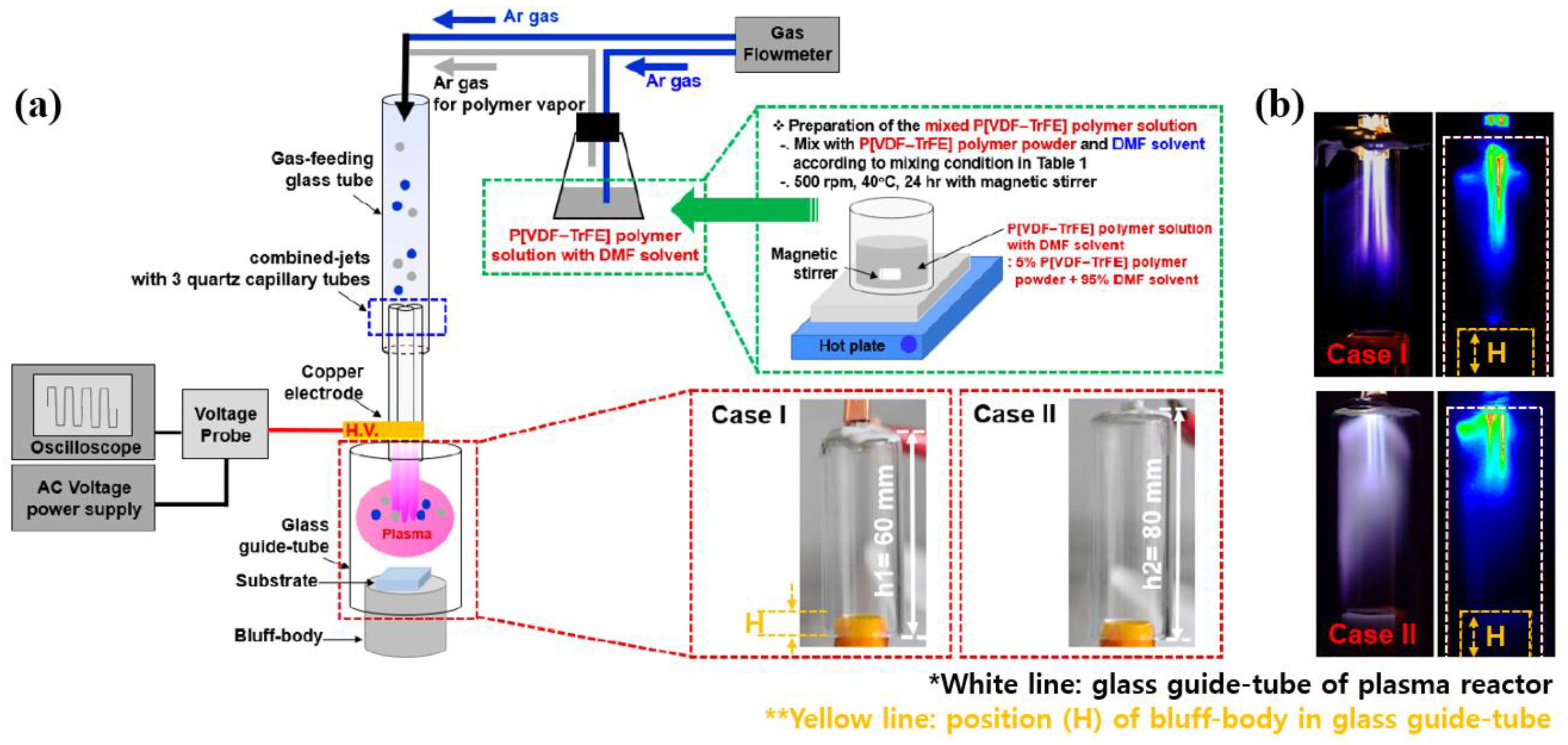

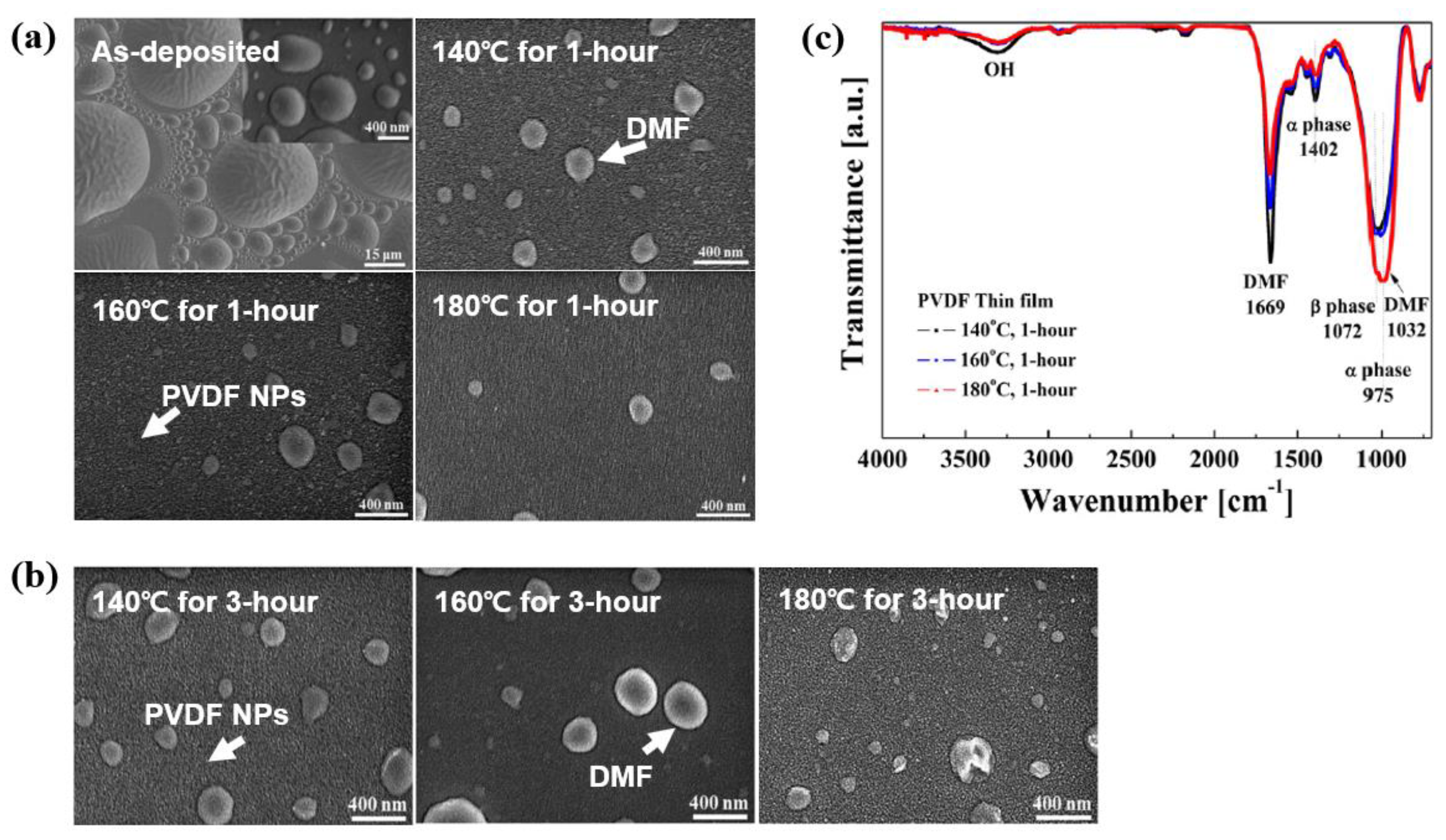
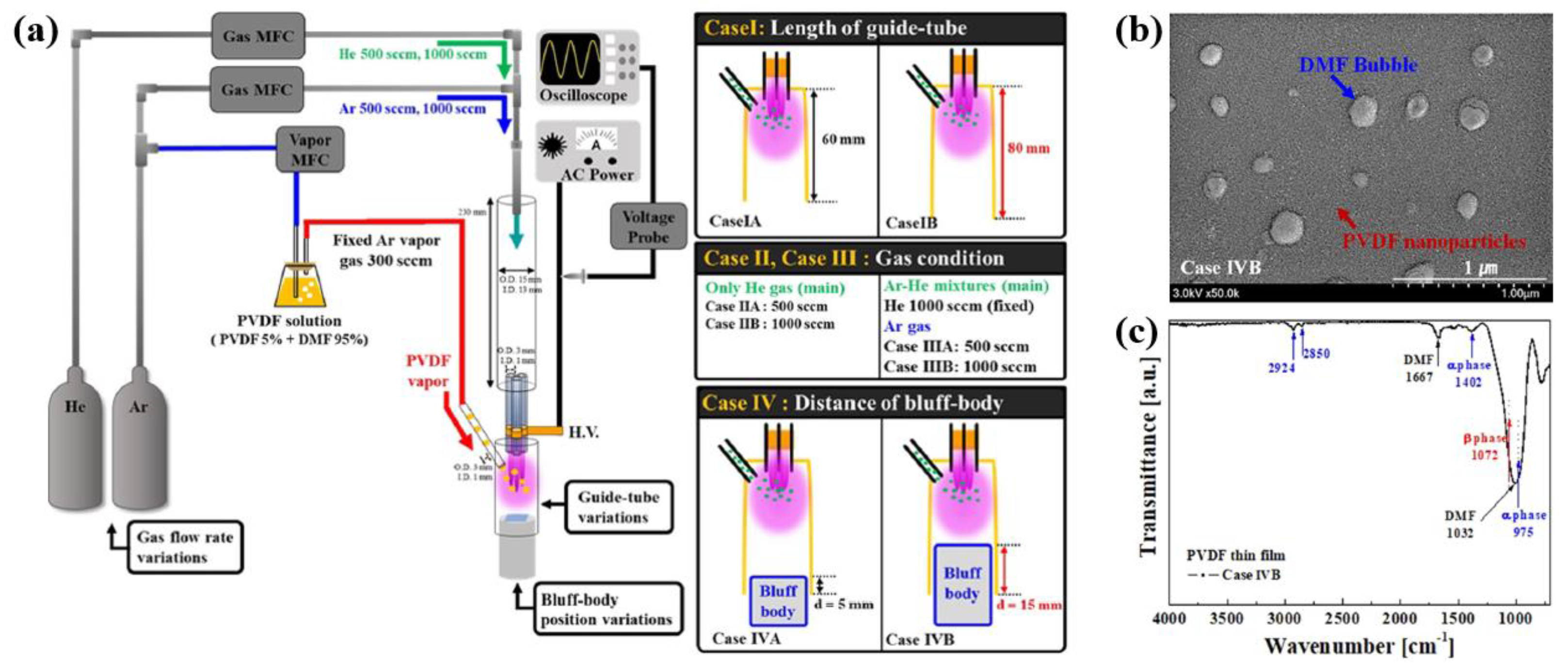






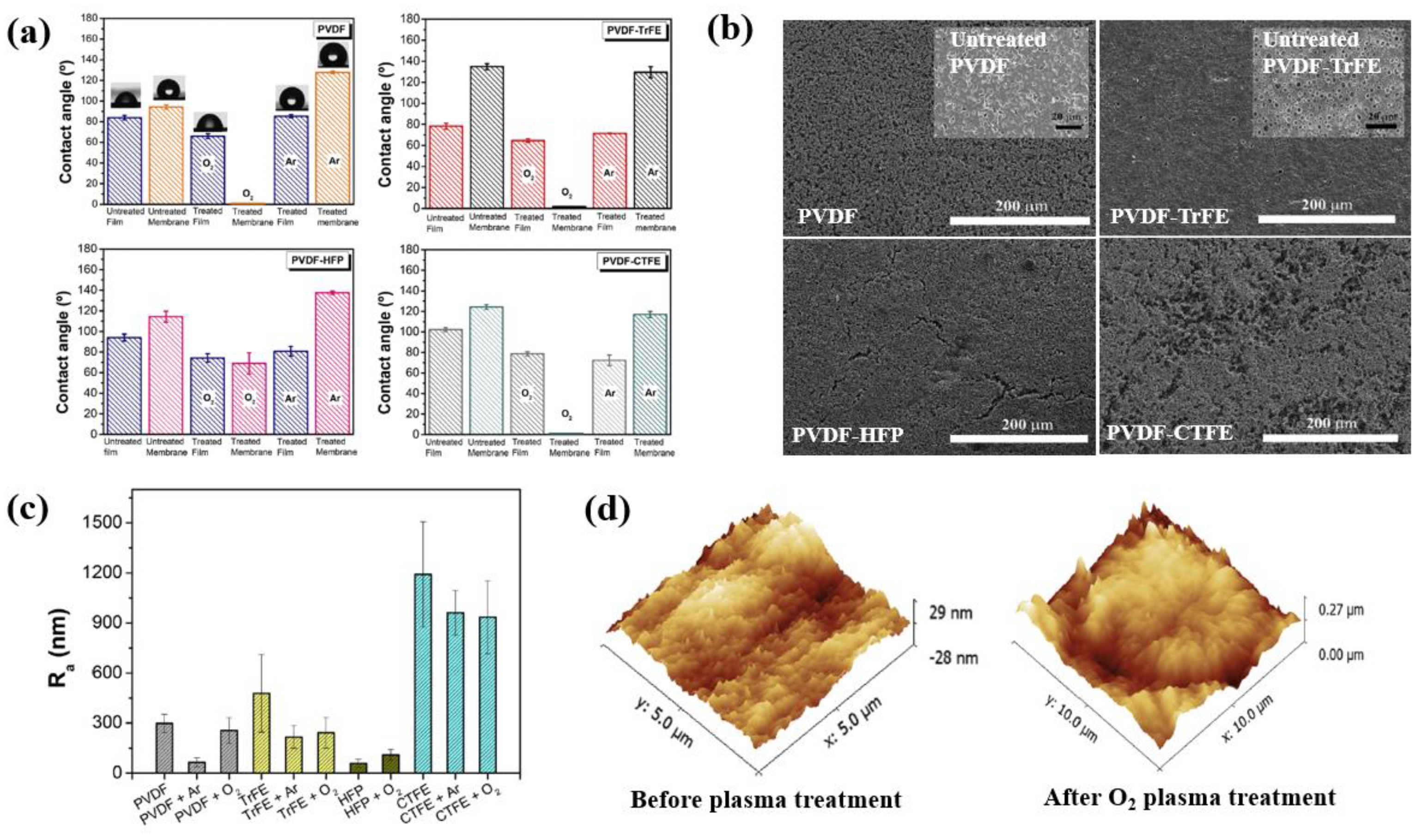


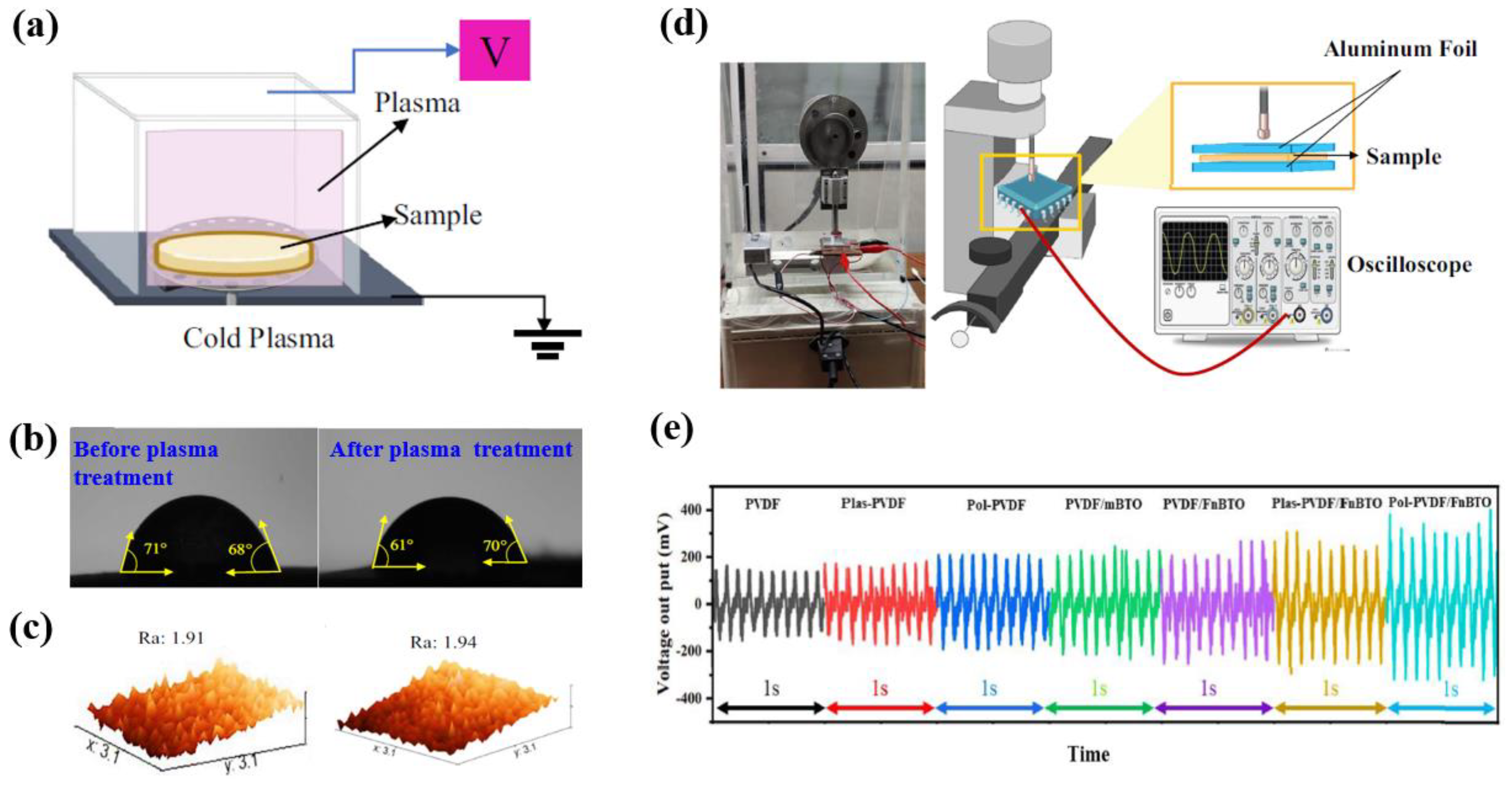
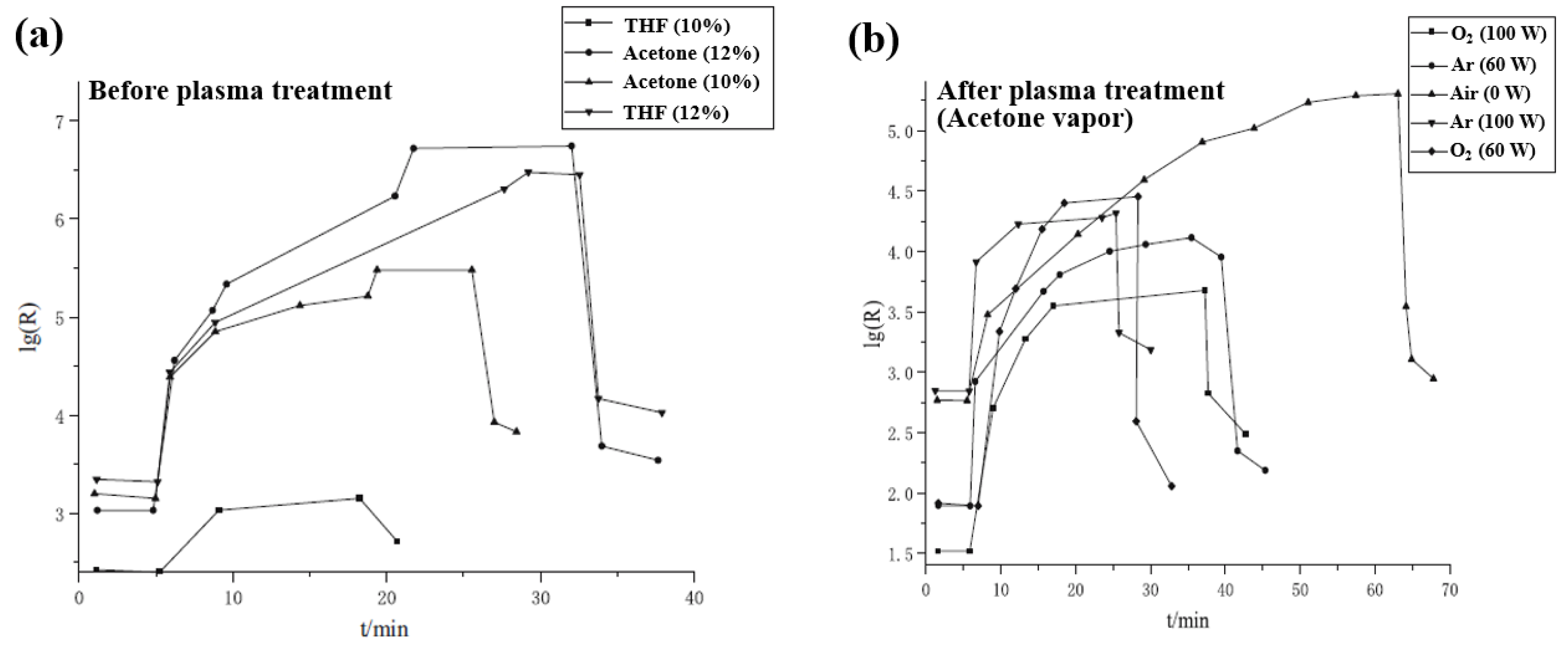

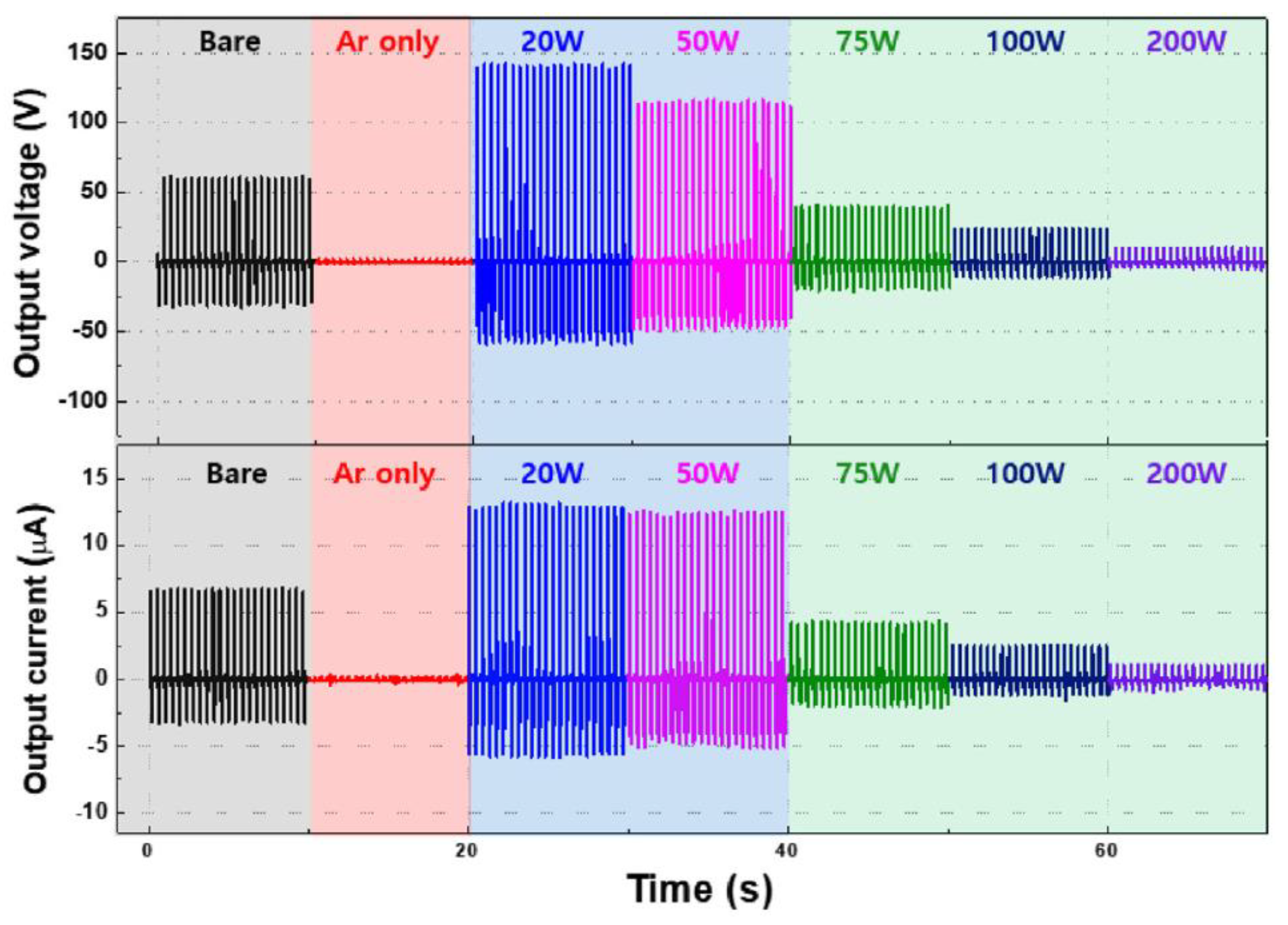





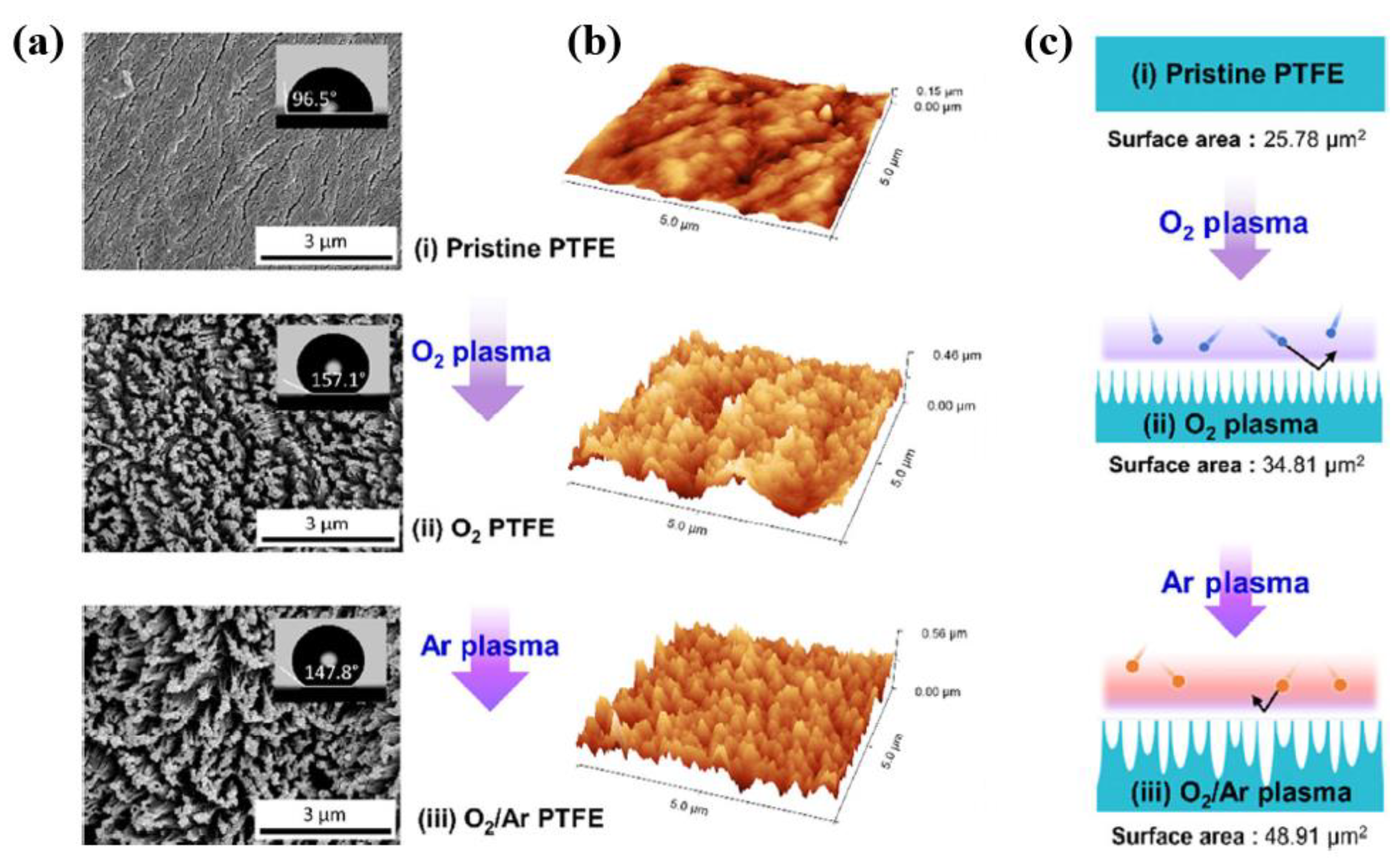



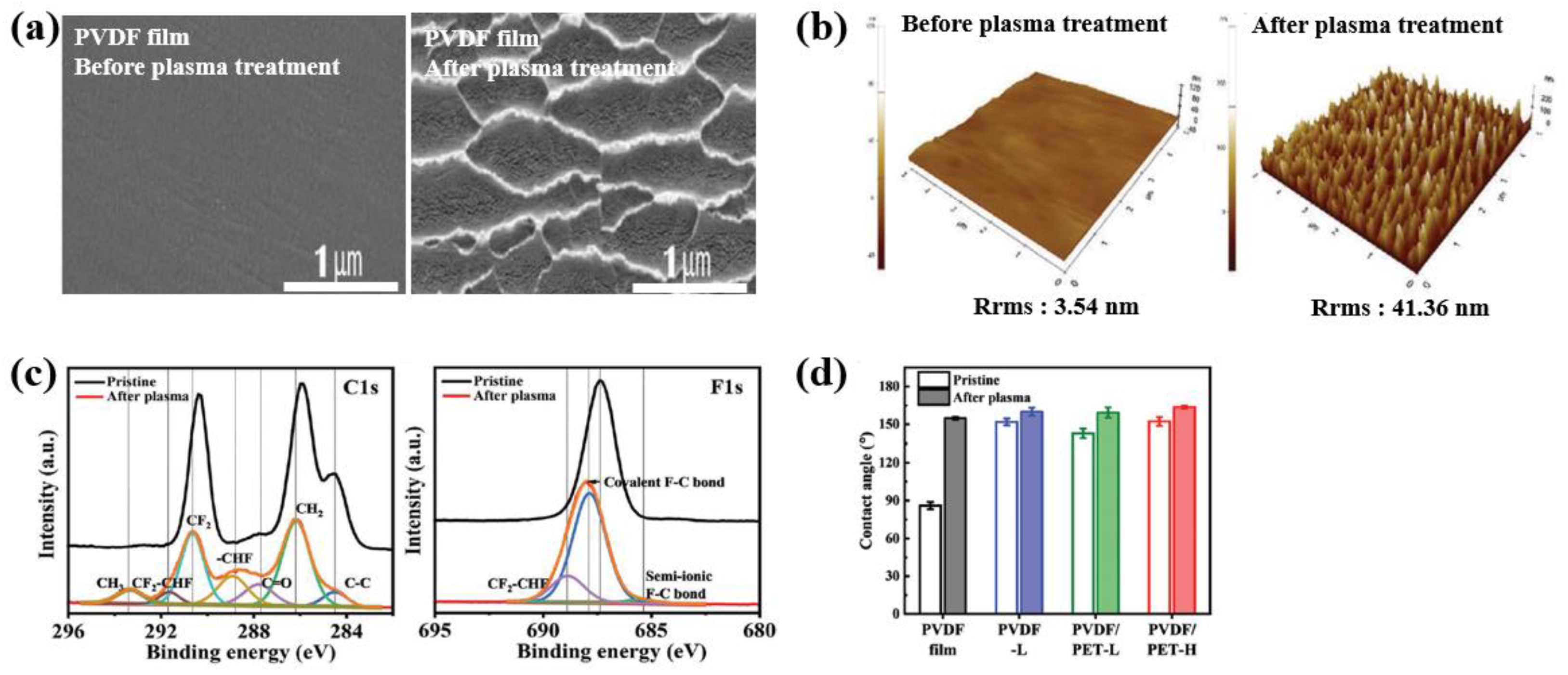



| No | Object | Plasma Source | Application | Year | Author Reference |
|---|---|---|---|---|---|
| 1 | ZnO thin films | PECVD (2.45 GHz microwave, 500 W) | PENGs | 2023 | García–Casas et al. [35] |
| 2 | ZnO/CF composites | Plasma–liquid technology (1.5 kV) | PENGs | 2023 | Zhong et al. [36] |
| 3 | ZnO NPs | APPJ | PENGs | 2023 | Schwan et al. [37] |
| 4 | ZnO thin film | PE–ALD | PENGs | 2020 | Ali et al. [38] |
| No | Object | Precursor | Plasma Source | Application | Year | Author Reference |
|---|---|---|---|---|---|---|
| 1 | P[VDF-TrFE] copolymer thin film | 5% P[VDF-TrFE] copolymer nano powder + 95% DMF solvent | Bipolar pulse (12.5 kVp-p, 26 kHz) | PENGs | 2023 | Jung et al. [39] |
| 2 | PVDF film | 5% PVDF nano powder + 95% DMF solvent | Bipolar pulse (12.5 kVp-p, 26 kHz) | PENGs | 2019 | Jung et al. [40] |
| 3 | PVDF film | 5% PVDF nano powder + 95% DMF solvent | Bipolar pulse (10 kVp-p, 26 kHz) | PENGs | 2022 | Bae et al. [41] |
| No | Object | Plasma Source | Application | Year | Author Reference |
|---|---|---|---|---|---|
| 1 | ZnO NFs | O2 and H2 plasma by ICPS (13.56 MHz, 30 Pa, 450 W) | Sensor | 2020 | Du et al. [42] |
| 2 | Au-ZnO films | Ar plasma (CY-P2L-300W) (25 Pa, 100 W) | Sensor | 2023 | Wang et al. [43] |
| 3 | ZnO–SnO2 NFs | Ar plasma by Hall ion source | Sensor | 2020 | Hu et al. [44] |
| No | Object | Plasma Source | Application | Year | Author Reference |
|---|---|---|---|---|---|
| 1 | PVDF and its copolymer (PVDF–HFP, P[VDF–TrFE], PVDF–CTFE) | RF frequency pulse (100 W, 40 kHz) | PENGs | 2019 | Correia et al. [45] |
| 2 | PZT-PDMS composite film | Low (or vacuum) and atmospheric pressure N2 plasma (300 V, 21.5 kHz) | PENGs | 2021 | Sappati et al. [46] |
| 3 | PVDF film and nanofiber | Atmospheric pressure corona plasma (6 kV) | PENGs | 2023 | Sultana et al. [47] |
| 4 | PVDF–BaTiO3 film | Atmospheric pressure plasma (12 kV, 5 kHz) | PENGs | 2024 | Fathollahzadeh et al. [48] |
| 5 | PVDF/CB composite film | Capacitively coupled plasma (13.56 MHz) | Sensor | 2022 | Wang et al. [49] |
| No | Object | Plasma Source | Application | Year | Author Reference |
|---|---|---|---|---|---|
| 1 | PDMS | RIE plasma (20 W) | TENGs | 2019 | Lee et al. [50] |
| 2 | PTFE | Ar plasma (50 mW) | TENGs | 2021 | Kong et al. [51] |
| 3 | SEBS | O2 plasma | TENGs | 2022 | Cho et al. [52] |
| 4 | SMCs–PDMS film | RF plasma (100 W) | TENGs | 2022 | Lee et al. [53] |
| 5 | PTFE | CCP plasma Ar and O2 plasma (100 W, 50 kHz) | TENGs | 2022 | Prada et al. [54] |
| 6 | Ecoflex film | Plasma cleaner (Harrick plasma, PDC-002) | TENGs | 2022 | Chen et al. [55] |
| 7 | PTFE | RF plasma (60 W) | TENGs | 2023 | Ahmed et al. [56] |
| 8 | PVDF fabrics | RIE plasma (Plasmalab 80Plus, UK) O2 and CF4 plasma (180 W) | TENGs | 2023 | Hong et al. [57] |
| 9 | Eggshell membranes (EMs) | N2 plasma (Harrick Plasma, PDC–32G) (18 W) | TENGs | 2023 | Lin et al. [58] |
| 10 | PTFE | Ar plasma (150 W) | TENGs | 2023 | Min et al. [59] |
Disclaimer/Publisher’s Note: The statements, opinions and data contained in all publications are solely those of the individual author(s) and contributor(s) and not of MDPI and/or the editor(s). MDPI and/or the editor(s) disclaim responsibility for any injury to people or property resulting from any ideas, methods, instructions or products referred to in the content. |
© 2024 by the authors. Licensee MDPI, Basel, Switzerland. This article is an open access article distributed under the terms and conditions of the Creative Commons Attribution (CC BY) license (https://creativecommons.org/licenses/by/4.0/).
Share and Cite
Jung, E.-Y.; Suleiman, H.O.; Tae, H.-S.; Park, C.-S. A Review of Plasma-Synthesized and Plasma Surface-Modified Piezoelectric Polymer Films for Nanogenerators and Sensors. Polymers 2024, 16, 1548. https://doi.org/10.3390/polym16111548
Jung E-Y, Suleiman HO, Tae H-S, Park C-S. A Review of Plasma-Synthesized and Plasma Surface-Modified Piezoelectric Polymer Films for Nanogenerators and Sensors. Polymers. 2024; 16(11):1548. https://doi.org/10.3390/polym16111548
Chicago/Turabian StyleJung, Eun-Young, Habeeb Olaitan Suleiman, Heung-Sik Tae, and Choon-Sang Park. 2024. "A Review of Plasma-Synthesized and Plasma Surface-Modified Piezoelectric Polymer Films for Nanogenerators and Sensors" Polymers 16, no. 11: 1548. https://doi.org/10.3390/polym16111548






